Systemic in vivo distribution of activatable cell penetrating peptides is superior to that of cell penetrating peptides
- PMID: 20023744
- PMCID: PMC2796831
- DOI: 10.1039/b904878b
Systemic in vivo distribution of activatable cell penetrating peptides is superior to that of cell penetrating peptides
Abstract
Cell penetrating peptides (CPPs) have been developed as vehicles for payload delivery into cells in culture and in animals. However several biologic features limit their usefulness in living animals. Activatable cell penetrating peptides (ACPPs) are polycationic CPPs whose adsorption and cellular uptake are minimized by a covalently attached polyanionic inhibitory domain. Cleavage of the linker connecting the polyanionic and polycationic domains by specific proteases (tumor associated matrix metalloproteases discussed herein) dissociates the polyanion and enables the cleaved ACPP to enter cells. In contrast to their CPP counterpart, ACPPs are relatively nonadherent and distributed uniformly to normal tissues. While nonaarginine (r(9)) CPP administered intravenously into mice initially bind to the local vasculature and redistribute to the liver, where >90% of the injected dose accumulates 30 min after injection. Regardless of the presence of the polyanionic inhibitory domain, confocal imaging of live tissues reveals that the majority of the ACPP and CPP remain in punctate organelles, presumably endosomes. Therefore further improvements in the efficiency of delivery to the cytosol and nucleus are necessary. In addition to improved target specificity, a major advantage of ACPPs over CPPs for potential clinical applications is reduced toxicity. Systemically administered r(9) CPP causes acute toxicity in mice at a dose 4-fold lower than the MMP cleavable ACPP, a complication not observed with an uncleavable ACPP presumably because the polycationic charge remains masked systemically. These data suggest that ACPPs have greater potential than CPPs for systemic delivery of imaging and therapeutic agents.
Figures
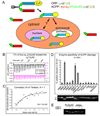
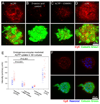
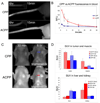
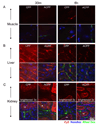
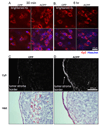
Similar articles
-
In vivo characterization of activatable cell penetrating peptides for targeting protease activity in cancer.Integr Biol (Camb). 2009 Jun;1(5-6):382-93. doi: 10.1039/b904890a. Epub 2009 May 11. Integr Biol (Camb). 2009. PMID: 20023745 Free PMC article.
-
Tumor targeting of MMP-2/9 activatable cell-penetrating imaging probes is caused by tumor-independent activation.J Nucl Med. 2011 Feb;52(2):279-86. doi: 10.2967/jnumed.110.082503. Epub 2011 Jan 13. J Nucl Med. 2011. PMID: 21233187
-
Enhancing cellular uptake of activable cell-penetrating peptide-doxorubicin conjugate by enzymatic cleavage.Int J Nanomedicine. 2012;7:1613-21. doi: 10.2147/IJN.S30104. Epub 2012 Mar 26. Int J Nanomedicine. 2012. PMID: 22619516 Free PMC article.
-
Cell penetration: scope and limitations by the application of cell-penetrating peptides.J Pept Sci. 2014 Oct;20(10):760-84. doi: 10.1002/psc.2672. Epub 2014 Aug 11. J Pept Sci. 2014. PMID: 25112216 Review.
-
[The application of enzyme-sensitive activatable cell-penetrating peptides to targeted delivery system].Yao Xue Xue Bao. 2015 Feb;50(2):141-7. Yao Xue Xue Bao. 2015. PMID: 25975019 Review. Chinese.
Cited by
-
Combined TP53 mutation/3p loss correlates with decreased radiosensitivity and increased matrix-metalloproteinase activity in head and neck carcinoma.Oral Oncol. 2015 May;51(5):470-5. doi: 10.1016/j.oraloncology.2015.01.014. Epub 2015 Feb 27. Oral Oncol. 2015. PMID: 25735654 Free PMC article.
-
Chiral Cyclobutane-Containing Cell-Penetrating Peptides as Selective Vectors for Anti-Leishmania Drug Delivery Systems.Int J Mol Sci. 2020 Oct 12;21(20):7502. doi: 10.3390/ijms21207502. Int J Mol Sci. 2020. PMID: 33053805 Free PMC article.
-
Effect of poly-glutamate on uptake efficiency and cytotoxicity of cell penetrating peptides.IET Nanobiotechnol. 2016 Apr;10(2):87-95. doi: 10.1049/iet-nbt.2015.0030. IET Nanobiotechnol. 2016. PMID: 27074859 Free PMC article.
-
Hexokinase 2 in Cancer: A Prima Donna Playing Multiple Characters.Int J Mol Sci. 2021 Apr 29;22(9):4716. doi: 10.3390/ijms22094716. Int J Mol Sci. 2021. PMID: 33946854 Free PMC article. Review.
-
Mitochondrial adaptation in cancer drug resistance: prevalence, mechanisms, and management.J Hematol Oncol. 2022 Jul 18;15(1):97. doi: 10.1186/s13045-022-01313-4. J Hematol Oncol. 2022. PMID: 35851420 Free PMC article. Review.
References
-
- Torchilin VP. Tat peptide-mediated intracellular delivery of pharmaceutical nanocarriers. Adv. Drug Deliv. Rev. 2008;60:548–558. - PubMed
-
- Patel LN, Zaro JL, Shen WC. Cell penetrating peptides: intracellular pathways and pharmaceutical perspectives. Pharm. Res. 2007;24:1977–1992. - PubMed
-
- Lundberg M, Johansson M. Is VP22 nuclear homing an artifact? Nat. Biotechnol. 2001;19:713–714. - PubMed
-
- Richard JP, Melikov K, Vives E, Ramos C, Verbeure B, Gait MJ, Chernomordik LV, Lebleu B. Cell-penetrating peptides. A reevaluation of the mechanism of cellular uptake. J. Biol. Chem. 2003;278:585–590. - PubMed
-
- Schwarze SR, Ho A, Vocero-Akbani A, Dowdy SF. In vivo protein transduction: delivery of a biologically active protein into the mouse. Science. 1999;285:1569–1572. - PubMed
Publication types
MeSH terms
Substances
Grants and funding
LinkOut - more resources
Full Text Sources
Other Literature Sources

